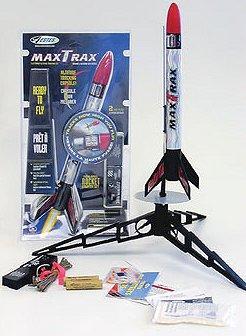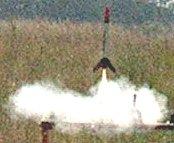| Construction Rating: | starstarstar_borderstar_borderstar_border |
| Flight Rating: | starstar_borderstar_borderstar_borderstar_border |
| Overall Rating: | starstar_borderstar_borderstar_borderstar_border |
| Manufacturer: | Estes  |
 Brief:
Brief:
A new member showed up at our launch one weekend with a MaxTrax (EST1434), a
new starter set from Estes that included an altimeter payload. He had flown it
once before and it had claimed an altitude of over 700 feet on a C6-5. When he
flew it at our launch, he used the other included motor, a B6-4, and it
registered over 350 feet. The shock cord separated, but after some repairs
carried out by some of our other members, the bird flew again that day.
At the time, few on-line vendors even listed the MaxTrax, and those that did had it marked as "overdue" or "not released". The flyer in question found his at a local Meijer, and as I had to go get cat food that evening ("uh ... yea, cat food, that's the ticket"), I stopped by the new rocket display at my local store, and there one was. The price was a stunning $21.99 (list is $39.99 and the cheapest I saw it on-line was ~$28), so I snapped it up.
Modifications:
Recovery systems, as noted below.
Construction:
The altimeter is housed in a black styrene capsule that fits into the body
tube. On the other end is a foam rubber nose cone tip that fits over the molded
"thumb" of the altimeter bay. Despite claims to the contrary, two 1.5
V calculator button cells for the device are included. A nice touch. Mine were
Vinnic model L1154, though the more common silver oxide models 357 and A76
would last longer. Only one is required so the other is a spare. A very nice
touch. To install the battery, the capsule's rubber tip and two tiny, deeply
recessed Phillips head screws must be removed and the halves folded open.
 The battery fits in
a molded holder in the "thumb" with a flip-away upper clip, and the
altimeter is in the body.
The battery fits in
a molded holder in the "thumb" with a flip-away upper clip, and the
altimeter is in the body.
The electronics are a custom PC board with a single chip covered in carrier material. The board also mounts the on-off switch, LCD display and shock sensor. Off-board is the ejection-detect switch that is held open by the body tube, and closes when the motor charge separates the capsule from the rocket. With only three moving parts and minimal wiring, the device promised to be relatively durable. I was a bit worried that ejection gasses might enter the bay though the two switch openings, but I've yet to see any evidence of that.
As I had designs on this little gizmo for some other birds, I wanted the thing back, so I modified the MaxTrax carrier rocket extensively before its first flight. I added a length of 300# Kevlar® and upgraded the elastic to 1/4 inch from the included 1/8th inch wide junk. I also replaced the included pre-built 12-inch plastic chute with the same size Rogue nylon unit, and added an HSPP-4Y Medium HeatShield from Pratt Hobbies. The altimeter capsule is supposed to recover by streamer, but as our launch site is surrounded by tall grass, I added a large snap-swivel to the elastic and hooked it to that. Total dry weight after the modifications was three ounces even, and with an estimated drag coefficient of 0.573, I predicted the altitudes found in the estimated performance table below.
Estimated Performance
| Engine(s) | AGL(ft.) | Speed(ft./sec.) | Accel(Gs) |
| B6-4 | 220 | 110 | 10.8 |
| C6-5 | 620 | 200 | 12.2 |
| D21-7 | 1,395 | 490 | 29.2 |
As Estes only requires you to assemble the pad, insert the included battery and attach the parachute to the shock cord, the assembly of the bird in stock configuration is pretty easy. As it is likely to fail after just a few flights, though, I'd only rate this bird a 2 on the Essence scale for assembly, needs improvement.
Finishing:
The bird is a standard Estes BT-56-based RTF, with quick-change motor mount and
the new two-lug one-piece launch guide. The shock cord is attached though a
hole in the body tube to this, making for one of Estes' worst mounts ever, and
that's saying something. The body wrap is a nice silver holographic sticker, so
the bird will be easy to see in the air, and overall, the rocket is a rather
good-looking example of the RTF genre. The launch system is Estes' standard
Electron Beam, in all black.
Construction Rating: 2 out of 5
Flight:

I flew the bird nine times in my configuration, on five B6-4s and four C6-5s. I
didn't get an altitude reading once. I called Estes and they said that the
reason the thing wasn't working was because I had it tied to the parachute. I
reconfigured my MaxTrax back to the way Estes intended it to be, swapping out
the 12 inch parachute for a 9 inch version. I flew her on the recommended
motors again, with the following results.
| Motor | Descent(sec) | Alt(feet) | Alt(Meters) | Notes |
| B6-4 | 3.87 | 0 | 0 | Not armed, hit road |
| B6-4 | 5.22 | 182.3 | 55.6 | |
| B6-4 | 6.16 | 216.8 | 66.1 | |
| C6-5 | 12.82 | 228.4 | 69.8 | |
| C6-5 | 0 | 422.1 | 128.7 | |
| C6-5 | 0 | 148.2 | 45.2 | |
| C6-5 | 16.47 | 598.9 | 182.6 | Hit road |
| C6-5 | 13.97 | Not armed | ||
| C6-5 | 16.19 | 379.4 | 115.7 | |
| C6-5 | 16.41 | 741.9 | 226.2 | New unit |
| C6-5 | 17.03 | 313.2 | 95.5 | |
| C6-5 | 13.39 | Lost |
Fearing that the unit I had was defective, I broke out my back-up MaxTrax and flew it for the last three flights. The ejection sense switch on this unit was intermittent, and it took a little adjusting to get it to work consistently. The two readings I got from it were just as bad as the ones from the first unit, and this capsule was lost in only moderately tall grass on the third flight. Two of us saw right where it came down, but we gave up after thirty minutes of searching. The bird itself survived its repeated flights without damage.
This is how I think MaxTrax works. The ejection sense switch starts an internal timer, which is stopped by the shock switch when the unit hits the ground. The assumed descent rate is then multiplied by the elapsed time to determine the altitude. If the shock switch is activated prior to touchdown (the capsule does tumble pretty badly, the streamers did not keep either of my units pointed straight down), the altitude will be low. If the shock switch isn't activated at touchdown (as it will not be when tied to a parachute), no altitude will be displayed. If the capsule does not fall at the assumed descent rate, the altitude will be erroneous. While the idea behind the MaxTrax is ingenious, it just doesn't work in practice, at least not the way Estes has implemented it.
Recovery:
The bird is over stable and does have a tendency to weathercock. At 2.5 ounces
in stock trim, the B6-4 is late, but the C6-5 is nearly perfect. These are the
only two Estes motors you can fly in the stock bird, though, limiting the
altimeter to two general altitudes, somewhat boring. If it worked, that is; the
values I got from my two units just aren't believable. I'd rate the flight
characteristics of the MaxTrax a one on the Essence scale, needs a lot of
improvement.
Flight Rating: 1 out of 5
Summary:
When I initially saw MaxTrax, I imagined all the kids that would be using it
for their school science projects. Once I got some experience with the thing, I
realized that there were going to be a whole lot tearful young scientists and
frustrated Dads this year. Twenty-one flights on an RTF has got to be some kind
of record, but I'm afraid that my MaxTrax's durability was due to my preemptive
mods. Given the overall quality of the bird, poor altimeter design, limited
flight scope and ensuing high possibility of disappointment, I'd rate the
MaxTrax a 1½ overall on the Essence scale, needs drastic improvement.
Overall Rating: 1 out of 5
Other Reviews
- Estes MaxTrax By Nick Esselman (August 10, 2010)
I saw a thread on RMR about a new Estes' rocket with the capability to determine altitude. I decided to purchase one from the local Walmart. It is a Ready to Fly rocket (for all practical purposes) included with a starter set. Launch pad, controller and two motors (B6-4 and C6-5). The rocket is called the MaxTrax™. Walmart sold it for $18.99. You have to purchase a "button" battery for the ...
- Estes MaxTrax By Jeff Vincent
For those not familiar with the MaxTrax, it is a new starter kit from Estes with an onboard "Electronic Altimeter". This uses a capsule which drops at a fixed descent rate. The capsule physically senses ejection (apogee), times the interval until it detects landing, then outputs calculated altitude in feet and meters. Promising... I had a chance to fly the MaxTrax yesterday (Sat.), ...
 |
 |
Flights
Sponsored Ads
 |
 |











